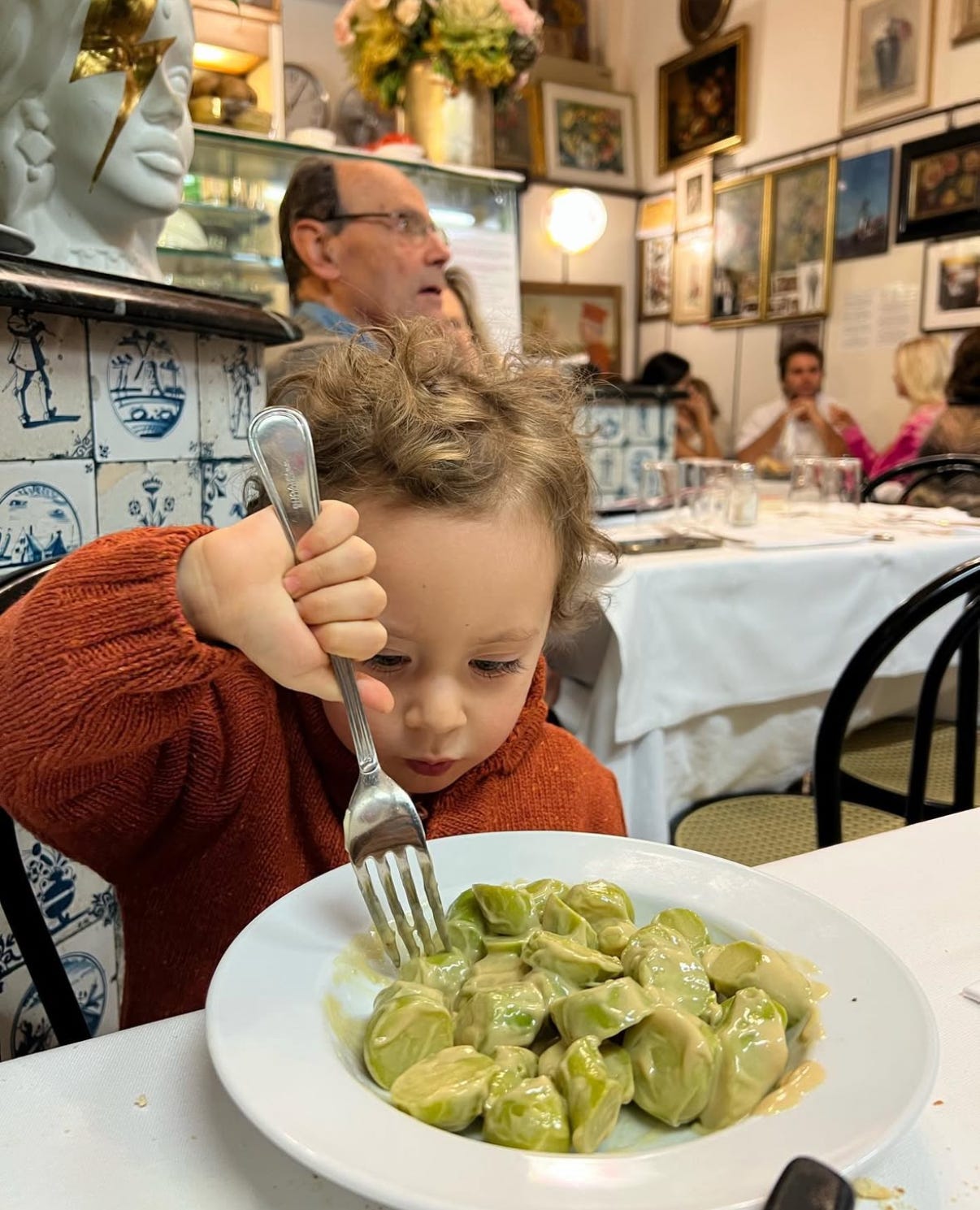Issue #197: Celery Root Rémoulade
Of Mustard and Dressings, the Return of a Favorite Restaurant
A few days in Paris, a couple more in Milan, a day trip to Florence—time spent in Europe is always restorative and inspiring, especially when it comes to food. We have eaten very well. And too much.

Our Paris restaurant itinerary was a combination of old and new, with a lot of bread and pastries thrown in. From the century-old Closerie des Lilas to Manon Fleury’s new plant-forward sensation Datil to Paris’s only modern sourdough pizzeria Oobatz, we managed a good mix. One of the highlights was of our own making, a little “pique-nique” indoors we arranged on Saturday afternoon, gathering a selection of cheeses from the fine affineur Laurent Dubois, fresh vegetables from a local primeurs shop, breads from my beloved Brigat’ bakery, and a selection of exceptional charcuterie from Maison Vérot.
Among the items we purchased from Vérot was the last of their display of celery root rémoulade, a salad I often make myself at home. A few days later at Closerie des Lilas, celery root rémoulade was among the starters on the lunch menu. I ordered it again. Their presentation was elegantly garnished with microgreens and dabs of honey dressing on the plate. It struck me that at this time of year, when new produce isn’t available and most roots have shriveled over winter, celery root rémoulade is a good recipe to share.
I’m a fan of root vegetable slaws in general (see beets, Issue #180), of which celery root rémoulade may be the epitome. It’s simple to the point of being elemental and its flavor always makes me think of France.
From what I can tell, celery root and celeriac are interchangeable terms. Some suggest the latter is the variety grown specially for its bulbous root, whereas the former is the root of the plant grown for its stalks. Even if this were ever the case, today the distinction is meaningless. Use whichever you prefer.
Cutting the Mustard Mustard
On this trip to Paris and my last, one thing I realized is that I’m too timid with mustard in my vinaigrettes and other salad dressings. Every time I’ve ordered a salad here, there’s been a pronounced mustard flavor, a nose-tingling sharpness that I love. I’ve vowed to up the mustard quotient of my dressings. The rémoulade at Closerie des Lilas was remarkable for its beauty and its bite.
A little research reveals that the word rémoulade is thought to have originated in the early 19th century, its name derived from remolat, a dialectical word for horseradish that is also related to the Italian word remolaccio, a type of wild horseradish. This might explain the pungency of the salads I’ve enjoyed that quite literally almost brought tears to my eyes. A few recipes for rémoulade I’ve seen include prepared horseradish, though adding enough mustard negates the need. Mustard seeds and horseradish share the compound alkyl isothiocyanate (AITC), which gives them their distinctive piquancy.
This mustard effect wasn’t limited to our Parisian meals. In Milan, we found ourselves back at Latteria San Marco, one of my all-time favorite restaurants (see Issue #32), which closed “for good” in December of 2023 after a 57-year run. Several months ago, while eating breakfast in New Hampshire, I received a text from Milan from my friend Elizabeth de Filippo-Jones that included a photo taken from what looked like a table at Latteria.
But how could this be? They had been closed many months by then. Turns out, as Elizabeth was to discover and later write about here, the restaurant was purchased by textile and fashion brand (and Latteria neighbor) Loro Piana and reopened with owners Arturo and Maria back in action for several months to train the new staff. In fact, the opportunity to enjoy one last meal at Latteria was the inspiration for our trip, timed also as a birthday celebration for Nate. (To stay on top of what’s happening in Milan and northern Italy, you should subscribe to Elizabeth’s Risotto and Steel Substack.)
Latteria Reborn
Walking into Latteria, it felt as though nothing had changed. The same elegant Milanese were eating lunch with a few tourists from Asia among them. Maria was at the door, Arturo was in the kitchen. Marco, their son, was behind the bar, working the cash and the espresso machine, as always. Perhaps fewer mementos were hanging on the walls (my photo was gone). Maybe more staff were moving about the room.
Our meal was as good as ever, maybe better. Despite being brought out of retirement and back into service—he’s 87, she’s only a little younger—Arturo and Maria looked better than ever. A year of rest was becoming.
Among the many vegetable side dishes on the familiar but ever-changing menu, was zucchine bollite con salsa di senape, “boiled zucchini with mustard sauce,” another prime example of AITC well deployed. Though it may not sound that appealing, I’ve always loved this dish, this sauce, especially when the zucchini it came with were of the long, thin, light-green variety known at trombette or tromboncini, which were new to me when I first encountered them at Latteria. Not in season at the moment, instead dense, flavorful Romanesco zucchini wore their spicy robe just as well.
All of which is to say, don’t be afraid to use more mustard than your think.
When it comes to mustard for salad and vegetable preparations, I reach for Dijon, preferably one that doesn’t have a lot of preservatives (read the label). Dijon mustard is not a protected geographical product like many other European products are, so the quality and flavor can vary considerably. Some are bitter, some are spicier. I find Moutarde Clovis a good standard brand and Trader Joe’s also has one that is preservative free. (See Issue #68 for more of my thoughts on the stuff.)
Once you find a Dijon you like, don’t hold back. Mustard up whatever you are making to the fullest.
RECIPE: Celery Root Rémoulade
Makes about 6 side-dish servings
1/2 large celery root (about 3/4 pound, give or take)
Sea salt
Juice of 1 lemon
3 to 4 tablespoons Dijon mustard
¼ cup white wine vinegar, champagne vinegar, or cider vinegar
1/2 cup extra-virgin olive oil
2/3 cup mayonnaise or plain, full-fat Greek yogurt
Handful chopped fresh parsley
Freshly ground black pepper
With a sharp paring knife or vegetable peeler, remove the peel from the celery root. Use the knife to dig out and cut away any brown spots or embedded dirt. Rinse and pat dry. Using a mandolin or very sharp knife, thinly slice the peeled celery root. Stack the thin slices and then julienne them into thin strips. Place the julienned celery root into a large mixing bowl. Toss with a generous pinch of salt and the lemon juice and let sit for about 30 minutes to soften.
Meanwhile, in a small mixing bowl, beat together the mustard, a pinch of salt, and the vinegar of choice. Slowly whisk in the olive oil to create an emulsion. Whisk in the mayonnaise or yogurt until blended. Taste. The mustard flavor should be pronounced. If not, add some more.
Once the celery root has sat, add the dressing, the parsley, and some freshly ground black pepper, and toss to coat. If you have time to let the rémoulade sit for a bit before serving, even better.






